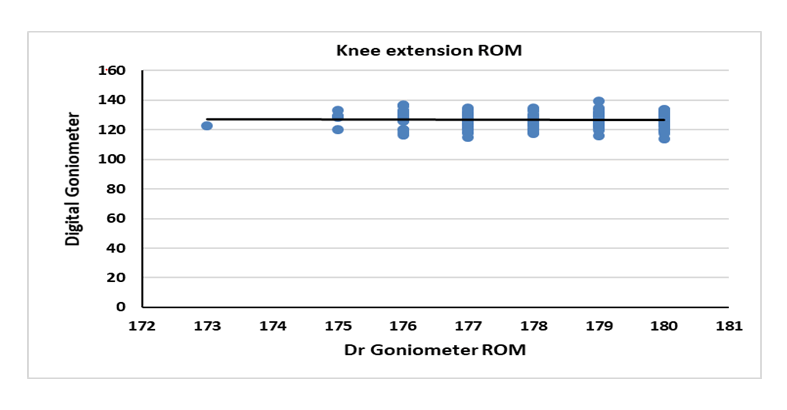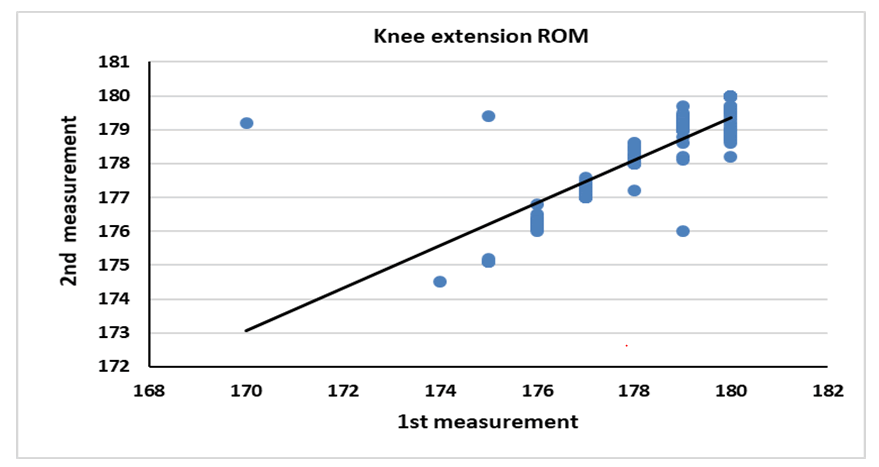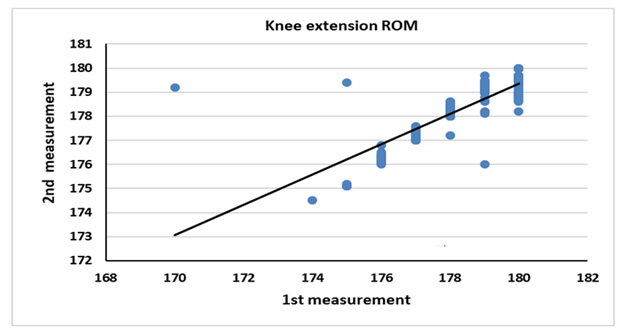Current Pediatric Research
International Journal of Pediatrics
Evaluation of knee range of motion by a smartphone application on schoolaged children.
Zeinab A Hussein*, Shimaa M Reffat
Department Physical Therapy for Pediatrics, Disturbance of Growth and Development Disorders in Children and its Surgery, Cairo University, Cairo, Egypt
- Corresponding Author:
- Zeinab A Hussein
Department Physical Therapy for Pediatrics, Disturbance of Growth and Development Disorders in Children and its Surgery, Cairo University, Cairo, Egypt
E-mail: shimaa_dpt@cu.edu.eg
Received: 07 January, 2022, Manuscript No. AAJCP-22-51376; Editor assigned: 10 January, 2022, PreQC No. AAJCP-22-51376(PQ); Reviewed: 25 January, 2022, QC No. AAJCP-22-51376; Revised: 19 February, 2022, Manuscript No. AAJCP-22-51376(R); Published: 28 February, 2022, DOI:10.35841/0971-9032.26.2.1235-1239
Purpose: To evaluate the validity and intra-reliability of Dr. Goniometer application in measuring knee range of motion on school-aged children. Materials and Methods: 150 school-aged children, ranging in age from 12 to 16, were all free of anthropometric differences that would prevent joint range. To compare ROM measurements taken with the Dr. Goniometer a within session test-retest design was adopted. Results: The validity ROM of this investigation revealed a significant difference in knee flexion (r=0.88 and p=0.0001) and a non-significant difference in knee extension (r=-0.06 and p=0.42). Conclusion: The Dr. Goniometer app might be used in a clinical situation comparable to that of the study, allowing rehabilitation physicians and therapists to acquire precise measurements of ROM using a smartphone in daily clinical practice.
Keywords
Range of motion; Smartphone application; Dr Goniometer application; Digital goniometer; Validity; Reliability.
Introduction
Range of Motion (ROM) is a precise and repeatable measurement of a joint's ability to move in static, dynamic, passive, or active settings, and it indicates joint functional ability [1-3]. ROM is an important ability in the rehabilitation process because it allows the physical therapist to choose suitable procedural therapies and track progress, particularly in musculoskeletal diseases [3,4]. Visual estimation or long-arm goniometry (universal and digital goniometers) have typically been used to assess ROM [5-7]. It has very good inter-rater and inter-rater reliability as universal goniometer with no statistical difference between them [8]. The amount of downloaded programme that turn a smartphone into a medical instrument is expanding, which is fueling the growth of smartphone technology in healthcare [9]. The app technology does not necessitate advanced hand skills, training, or knowledge of surface anatomy, and it is cost-effective [10].
Dr. Goniometer, an iPhone-based (Apple Inc., Cupertino, California, USA) application that works as a virtual goniometer that provides an alternate or supplementary method of measuring, helpful for many needs, was recently released [11,12]. Because the usage of app technology in children and teenagers is limited, validation studies on the Dr. Goniometer app that focuses on goniometric measurement are still needed [13-15]. The goal of this study was to compare the validity and intra-rater of the Dr. Goniometer for measuring joint angle at the knee to that of the commonly used digital goniometer in teenagers.
Materials and Methods
Subjects
A sample of 150 young healthy children was recruited for this study. Participants were included if they mean ± SD age, weight, height, and BMI were 14.05 ± 1.41 years, 47.82 ± 8.13 kg, 158.75 ± 8.14 cm and 19.01 ± 1.73 kg/m² respectively. The sex distribution of the study group revealed that there were 71 girls with reported percentage of 47.3% while the number of boys was 79 with reported percentage of 52.7% all children will free from significant musculoskeletal pathology or pain, and anthropometric variation that would preclude joint range of motion measurement. Approval letter from faculty of physical therapy, Cairo university was obtained to begin the current study and written informed letters were sent to the ministry of education in El-Gharbia government take permission from school administrators in EL Santa City. School administrators collected children to be participated in this study and took their permission in a written consent forms.
Materials
The purpose of this study was to see if a Smartphone application could offer a reliable and valid evaluation of active knee ROM using validity, test–retest reliability approach. The validity of the smartphone was determined by comparing it to a Dr. Goniometer and a digital one. In addition, the digital goniometer's reliability and validity were evaluated in order to give a comparison with another therapeutically practical system of measurement.
Procedure
All of the individuals took two identical testing measurements about five days apart, with comparisons between and within measurements used to determine reliability and validity. A single physiotherapist performed all of the ROM testing. The examinations were carried out on the patient's right knee. Only the active range of motion was tested. Dr. Goniometer recorded three trials for each movement direction, and the median value was chosen for analysis [16].
At the moment of measurement, the findings for the digital goniometer and Smartphone were manually recorded. Explain the goal of the study to each child and provide a quick overview of Dr. Goniometer and why we utilize it in particular. The location of the knee joint during the measurements was standardized for all participants; the participants were recorded in the prone laying position (beginning position) with fully extended knees.
Participants in the flexion knee study were advised to bend their leg as far as feasible before marking their measurements. The ratter uses an inclinometer to find the perpendicular line. The virtual goniometer is installed in the Dr. Goniometer programme, moving several cursors on the photographed body landmarks with the fingers, straight on the small screen of the mobile phone [17]. The physician takes a picture of the limb, stores it, calculates the joint angle, and records the result [18].
After taking Dr. Goniometer data, a digital goniometer was used to measure the knee. With the knee treated as a hinge joint with one degree of rotation, the goniometer is centered on the lateral epicondyle and oriented towards the greater trochanter and lateral epicondyle [19].
Sample size
Sample size calculation was performed prior to the study using G*POWER statistical software (version 3.1.9.2; Franz Faul, Universidad Kiel, Germany) (correlational study, α=0.05, β=0.2, and medium effect size) and revealed that the appropriate sample size for this study was N=150.
Data analysis
The mean and SD for all measured variables were calculated using descriptive statistics. The correlation between the smart phone application and digital goniometer measurements was determined using the person product moment correlation coefficient to determine validity. Intra-reliability was explored using the person product moment correlation coefficient to determine the correlation between repeated measurements of a smart phone application. For all statistical tests, the significance level was set at p=0.05.
Results
The mean ± SD knee flexion and extension ROM measured by smart phone application were 53.42 ± 5.11 and 178.16 ± 1.56 respectively. The mean ± SD knee flexion and extension ROM measured by digital goniometer were 53.23 ± 5.09 and 126.86 ± 4.97 respectively.
| Smart phone application | Digital goniometer | |||
|---|---|---|---|---|
| Knee flexion | Knee extension | Knee flexion | Knee extension | |
| 53.42 | 53.42 | 53.23 | 126.86 ± 4.97 | |
| ± SD | ± 5.11 | ± 5.11 | ± 5.09 | |
| Range | 24.9 | 7 | 22.7 | 25.3 |
Table 1. Descriptive statistics of knee ROM measurements by smart phone application and digital goniometer.
Validity of smart phone application in measurement of knee range of motion
In the study group, the correlation between knee flexion ROM measured by smart phone application and that measured by digital goniometer was strong positive significant correlation (r=0.88, p=0.0001), whereas the correlation between knee extension ROM measured by smart phone application and that measured by digital goniometer was weak negative non-significant correlation (r=0.88, p=0.0001). (Table 2; Figures 1 and 2).
| Digital goniometer | r-value | p-value | Sig | |
|---|---|---|---|---|
| Dr. Goniometer | Knee flexion | 0.88 | 0.0001 | S |
| Knee extension | -0.02 | 0.74 | NS |
Table 2. Correlation between knee ROM that measured by smart phone application and that measured by digital goniometer of the study group: r-value: Pearson correlation coefficient; p-value: Probability value; S: Significant; NS: Non-significant.
The correlation between 1st and 2nd knee flexion and extension ROM measurements that measured by smart phone application in the study group was strong positive significant correlation (r=0.82, p=0.0001) (r=0.8, p=0.0001) respectively (Table 3; Figures 3 and 4).
| 2nd measurement | r-value | p-value | Sig | |
|---|---|---|---|---|
| 1st measurement | Knee flexion | 0.82 | 0.0001 | S |
| Knee extension | 0.8 | 0.0001 | S |
Table 3. Correlation between 1st and 2nd knee ROM measurements that measured by smart phone application of the study group: r-value: Pearson correlation coefficient; p-value: Probability value; S: Significant; NS: Non-significant.
Discussion
In order to make physical therapists' work as precise as possible, measurements must be precise in terms of reliability and validity. Musculoskeletal disorders such as fractures, contusions, or pain in the elbow and knee areas are more common in children than in adults, affecting their activity level and participation [20]. Simple and low-cost ways for collecting ROM data in the clinic must be compared to a gold standard.
When working with healthy school children, the Dr Goniometer app revealed that it is possible to assess elbow and knee active ROM in a valid and reliable manner. When compared to the gold standard "digital goniometer," measurements acquired using the Dr. Goniometer app performed very well across metrics of validity and intra-reliability [21].
The findings of this investigation show that the instrument has great intra-reliability and validity. This study's findings differ from earlier studies on goniometer applications in that it looks at the technology's capacity to reliably measure angles [22]. The Dr. Goniometer application may be a better technique of measuring than SG since viewing landmarks in a two-dimensional plane is easier and gives a record of the image and measurement. Dr. Goniometer software was found to be a reliable approach for measuring knee ROM and to be much easier to use than the traditional method.
Limitations
The participants in this study were healthy, which made it easier to locate anatomical landmarks, set the goniometer in the right area, and measure the ROM more accurately to patients with obesity, limb deformity, or orthotics.
Another drawback of this study was that we used the digital goniometer to measure the right knee since the digital goniometer we used in these measures was 180 degrees. Because photo-graphing was required, the investigator was not blinded to the measurements of previously collected trials.
Conclusion
Finally, Dr. Goniometer (a smart phone app) can be utilized in clinical practice and research as a simple and practical alternative to digital and universal goniometers. These findings show that the Dr. Goniometer may be used to evaluate active ROM (flexion and extension) of the knee joint because it has high intra-rater reliability and can be used interchangeably.
Acknowledgements
For All participants in the study and biostatistician who analyzes the results of the study.
Conflict of Interest
Not applicable.
Data Availability
Data is available on request from the corresponding author.
References
- Mourcou Q, Fleury A, Diot B, et al. Mobile phone-based joint angle measurement for functional assessment and rehabilitation of proprioception. Bio Med Research International 2015. [Crossref][Google Scholar][Indexed]
- García-Rubio J, Pino J, Olivares P, et al. Validity and reliability of the WIMUTM inertial device for the assessment of joint angulations. Int J Environ Res Public Health 2019; 17(1): 193. [Crossref][Google Scholar][Indexed]
- Svensson M, Lind V, LöfgrenHarringe M. Measurement of knee joint range of motion with a digital goniometer: A reliability study. Physiotherapy Research International, 2018; 24(2): 1765. [Crossref][Google Scholar][Indexed]
- Milani P, Coccetta CA, Rabini A, et al. Mobile smartphone applications for body position measurement in rehabilitation: A review of goniometric tools. PM R 2014; 6: 1038–43. [Crossref][Google Scholar][Indexed]
- Ockendon M, Gilbert RE. Validation of a novel smartphone accelerometer-based knee goniometer. J Knee Surg 2012; pp: 341-345. [Crossref][Google Scholar][Indexed]
- Ferriero G, Vercelli S, Sartorio F, et al. Reliability of a smartphone-based goniometer for knee joint goniometry. Int J Rehabil Res 2013; pp: 146-151. [Crossref][Google Scholar][Indexed]
- Charlton P, Mentiplay B, Pua Y. Reliability and concurrent validity of a smartphone, bubble inclinometer and motion analysis system for measurement of hip joint range of motion. J Sci Med Sport 2015: 18(3): 262-267. [Crossref][Google Scholar][Indexed]
- Hansson G-Å, Balogh I, Ohlsson K, et al. Measurement of wrist and forearm positions and movements: effect of, and compensation for, goniometer crosstalk. J Electromyogr Kinesiol 2004; 14(3): 355-67. [Crossref][Google Scholar][Indexed]
- Juul-Kristensen B, Hansson G-Å, Fallentin N, et al. Assessment of work postures and movements using a video-based observation method and direct technical measurements. Appl Ergon 2001; 32(5): 517-524. [Crossref][Google Scholar][Indexed]
- Svensson M, Lind V, LöfgrenHarringe M. Measurement of knee joint range of motion with a digital goniometer: A reliability study. Physiotherapy Research International 2019; 24(2): e1765. [Crossref][Google Scholar][Indexed]
- Terry M. Medical apps for smartphones. Telemed J E Health 2010; 16: 17–22. [Crossref][Google Scholar][Indexed]
- Ke ogh JWL, Cox A, Anderson S, et al. Reliability and validity of clinically accessible smartphone applications to measure joint range of motion: A systematic review. PLoS ONE 2019; 14(5): 1–24. [Crossref][Google Scholar][Indexed]
- Johnson LB, Sumner S, Duong T, et al. Validity and reliability of smartphone magnetometer-based goniometer evaluation of shoulder abduction: A pilot study. Man Ther 2015; 20: 777. [Crossref][Google Scholar][Indexed]
- Milanese S, Gordon S, Buettner P, et al. Reliability and concurrent validity of knee angle measurement: Smart phone app versus universal goniometer used by experienced and novice clinicians. Man Ther 2014; 19(6): 569–74. [Crossref][Google Scholar][Indexed]
- Ferriero G, Sartorio F, Foti C, et al. Reliability of a new application for smartphones (Dr. Goniometer) for elbow angle measurement. PM R 2011; 3: 1153–154. [Crossref][Google Scholar][Indexed]
- Ferriero G, Vercelli S, Sartorio F, et al. Reliability of a smartphone-based goniometer for knee joint goniometry. Int J Rehabil Res 2013; 36: 146–51. [Crossref][Google Scholar][Indexed]
- Bennett D, Hanratty B, Thompson N, et al. Measurement of knee joint motion using digital imaging. Int Orthop 33(6); pp: 1627-1631. [Crossref][Google Scholar][Indexed]
- Longoni L, Brunati R, Sale P, et al. Smartphone applications validated for joint angle measurement: A systematic review. Int J Rehabil Res 2019; 42(1): 11-19 [Crossref][Google Scholar][Indexed]
- Kolber MJ, Fuller C, Marshall J, et al. The reliability and con-current validity of scapular plane shoulder elevation meas-urements using a digital inclinometer and goniometer. Physiother Theory Pract 2012; 28: 161–168. [Crossref][Google Scholar][Indexed]
- Buck C, Martindale B, Braden HJ. Goniometry Apps?: Do They Measure Up?? Exploring the Accuracy of Mobile Device Apps. Crimson Publishers 2014; 5(2): 492-500. [Crossref][Google Scholar]
- Mitchell K, Gutierrez S, Sutton S, et al. Reliability and validity of goniometric iPhone applications for the assessment of active shoulder external rotation. Physiother Theory Pract 2014; 30(7): 521-525. [Crossref][Google Scholar][Indexed]
- Ferriero G, Vercelli S, Sartorio F, et al. Reliability of a smartphone-based goniometer for knee joint goniometry. Int J Rehabil Res 2013; 36: 146–51. [Crossref][Google Scholar][Indexed]



